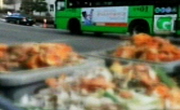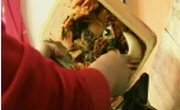국내의 4인 가족 가정의 음식물 쓰레기 발생량을 염분이 가미된 것과 염분이 가미되지 않은 것으로 구분하여 조사하였고, 음식물 쓰레기를 염분이 가미되지 않은 채소류, 곡류, 과일류, 염분...
http://chineseinput.net/에서 pinyin(병음)방식으로 중국어를 변환할 수 있습니다.
변환된 중국어를 복사하여 사용하시면 됩니다.
- 中文 을 입력하시려면 zhongwen을 입력하시고 space를누르시면됩니다.
- 北京 을 입력하시려면 beijing을 입력하시고 space를 누르시면 됩니다.

가정에서 발생한 서로 다른 종류의 음식물 쓰레기가 줄지렁이(Eisenia fetida)개체군의 섭식 및 생장에 치미는 영향 = The Effects of different food-wastes of household on the feeding rate and growth rate of Eisenia fetida(Annelida; Oligochaeta) population
한글로보기https://www.riss.kr/link?id=A105779038
- 저자
- 발행기관
- 학술지명
- 권호사항
-
발행연도
2013
-
작성언어
-
-
주제어
지렁이 ; 음식물 쓰레기 ; 자원재활용 ; 유기성 폐자원 ; 염분. earthworm ; food waste ; resource recycling ; vermicomposting.
-
KDC
570
-
등재정보
KCI등재
-
자료형태
학술저널
-
수록면
83-91(9쪽)
- 제공처
-
0
상세조회 -
0
다운로드
부가정보
국문 초록 (Abstract)
국내의 4인 가족 가정의 음식물 쓰레기 발생량을 염분이 가미된 것과 염분이 가미되지 않은 것으로 구분하여 조사하였고, 음식물 쓰레기를 염분이 가미되지 않은 채소류, 곡류, 과일류, 염분이 가미된 음식물 쓰레기로 구분하여 줄지렁이에게 공급하면서 지렁이의 섭식량 및 증식률을 조사하였다. 음식물 쓰레기량은 1가정 1주당 3,200 g(1인당 1일 0.114 kg)이었고, 그 중 염분이 가미되지 않은 것은 전체의 53.9%인 1,723.8 g 으로 나타났다. 함수율 70%를 가정하였을 때 채소류, 곡류, 과일류의 염도는 각각 0.60, 036, 0.33%이었고, 염분이 가미된 음식물 쓰레기의 염도는 0.78%이었다. 채소류, 과일류에서는 지렁이의 섭식은 잘 이루어졌으나 증체율이 낮았고, 곡류에서는 상대적으로 섭식량은 낮았지만 증체율이 높았다. 함수율 70%인 먹이의 염도가 0.6% 이상인 경우에는 지렁이의 섭식과 생장이 현저하게 둔화하였고, 0.3%인 경우에는 섭식은 정상적으로 이루어졌으나 생장이 약간 저해되었다. 따라서 염분이 가미된 음식물 쓰레기는 전처리과정 없이는 지렁이 처리가 불가능하며, 염분이 가미되지 않은 음식물 쓰레기는 지렁이 처리가 용이한 것으로 나타났다.
다국어 초록 (Multilingual Abstract)
The amount of salted food waste and non-salted food waste from household consisted of 4 family members was surveyed. And the feeding rate and growth rate of Eisenia fetida population upon the different food wastes such as vegetables, grains, fruits an...
The amount of salted food waste and non-salted food waste from household consisted of 4 family members was surveyed. And the feeding rate and growth rate of Eisenia fetida population upon the different food wastes such as vegetables, grains, fruits and salted food waste were investigated. Total amount of food waste from a household was
3,200g/week. i.e. 0.114kg/day/capita and non-salted food waste was 53.9% of food waste.
Salt contents of vegetables, grains, fruits were 0.60, 0.36 and 0.33%, respectively, if they were assumed to have 70% water content. Salt content of salted food waste was 0.78%.
Upon the non-salted vegetables and fruits, feeding rate of earthworm was high but growth rate was low. Upon the non-salted grains, feeding rate of earthworm was low but growth rate was high. Upon the food with 70% water content, earthworm could not feed and grow when salt content of food was over 0.6%, and earthworm could feed normally but showed low growth rate when salt content of food was 0.3%. These results indicated that earthworm could stabilize the non-salted food wastes with ease but could hardly stabilize the salted food wastes.
동일학술지(권/호) 다른 논문
-
하수중 인제거를 위한 정석탈인반응의 정석재로서 소각분말 용융슬래그의 이용 가능성 평가
- 유기성자원학회
- 김충곤
- 2013
- KCI등재
-
- 유기성자원학회
- 허관용(Heo, Gwan-Yong)
- 2013
- KCI등재
-
퇴비단 여과상이 부착된 혐기소화조를 이용한 돈분뇨 슬러리 메탄생산 효율분석
- 유기성자원학회
- 정광화(Kwang-Hwa Jeong)
- 2013
- KCI등재
-
- 유기성자원학회
- 정영훈(Jung, Yeoug-Hun)
- 2013
- KCI등재




 스콜라
스콜라






